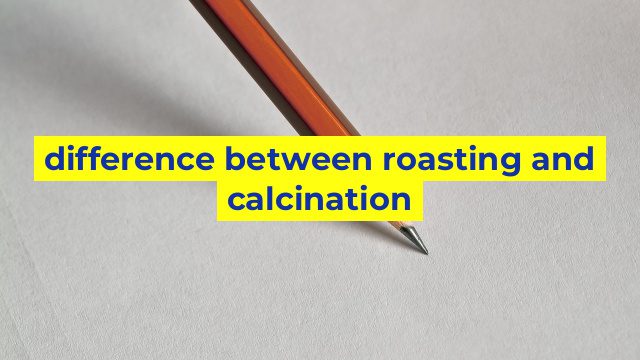The Difference between Roasting and Calcination
When it comes to processing materials, two common techniques are roasting and calcination. While it may seem that these two methods are interchangeable, they are in fact distinctly different processes with unique applications. In this article, we will explore the differences between these techniques.
Roasting
Roasting refers to heating a material in the presence of oxygen, typically in a furnace, to bring about a physical or chemical change. One of the most common uses of roasting is in the mining industry, where it is used to extract metals from ores. Roasting is also used for other applications, such as the treatment of metal sulfide concentrates, the preparation of catalysts, and the removal of impurities from materials.
During roasting, the material is exposed to temperatures ranging from 300°C to 800°C, depending on the specific application. The oxygen in the air reacts with the material, causing a chemical reaction to occur. The resulting product may be a metal oxide, a metal sulfide or a metal alloy, depending on the material being roasted.
Calcination
Calcination, on the other hand, involves heating a material in the absence of oxygen. The process is often used to drive off moisture, volatile organic compounds (VOCs), or other impurities from a material. This technique is widely used in many industries, including the production of cement, lime, and gypsum.
During calcination, the material is heated to temperatures ranging from 600°C to 1100°C. The process causes the material to break down and release any impurities. The resulting product is typically a powder or a solid that can be used for further processing or for its final application.
The Differences in Applications
While roasting and calcination may appear similar, they are used in vastly different applications. Roasting is used primarily in the mining industry, where it is used to extract metals from ores. Calcination, on the other hand, is used in a range of industries, including construction, agriculture, and food production.
Additionally, roasting is a chemical process that changes the material being roasted at the molecular level. Calcination is a physical process that drives off impurities, leaving the original material relatively unchanged.
Conclusion
In summary, roasting and calcination are two distinct techniques used in various industries. Roasting involves heating a material in the presence of oxygen to bring about a chemical change, while calcination involves heating a material in the absence of oxygen to remove impurities. Knowing the differences between these two techniques can help businesses and industries determine which is best suited for their specific material processing needs.
Table difference between roasting and calcination
Roasting vs Calcination
| Roasting | Calcination | |
|---|---|---|
| Definition | The process of heating a metal ore in the presence of air to convert the ore into its oxide form. | The process of heating a substance to a high temperature in the absence or limited supply of air to bring about thermal decomposition. |
| Purpose | To remove impurities, reduce the metal oxide to its pure form, or change the physical properties of the ore. | To drive off volatile compounds, remove water, or change the physical properties of the substance. |
| Temperature | Usually below the melting point of the metal. | Above the melting point of the substance. |
| Air Supply | Air is present during the process. | Absence or limited supply of air is required. |
| Examples | Roasting of sulfide ores to produce metal oxides (e.g. CuS + O2 → CuO + SO2). | Calcination of limestone to produce quicklime (e.g. CaCO3 → CaO + CO2). |


